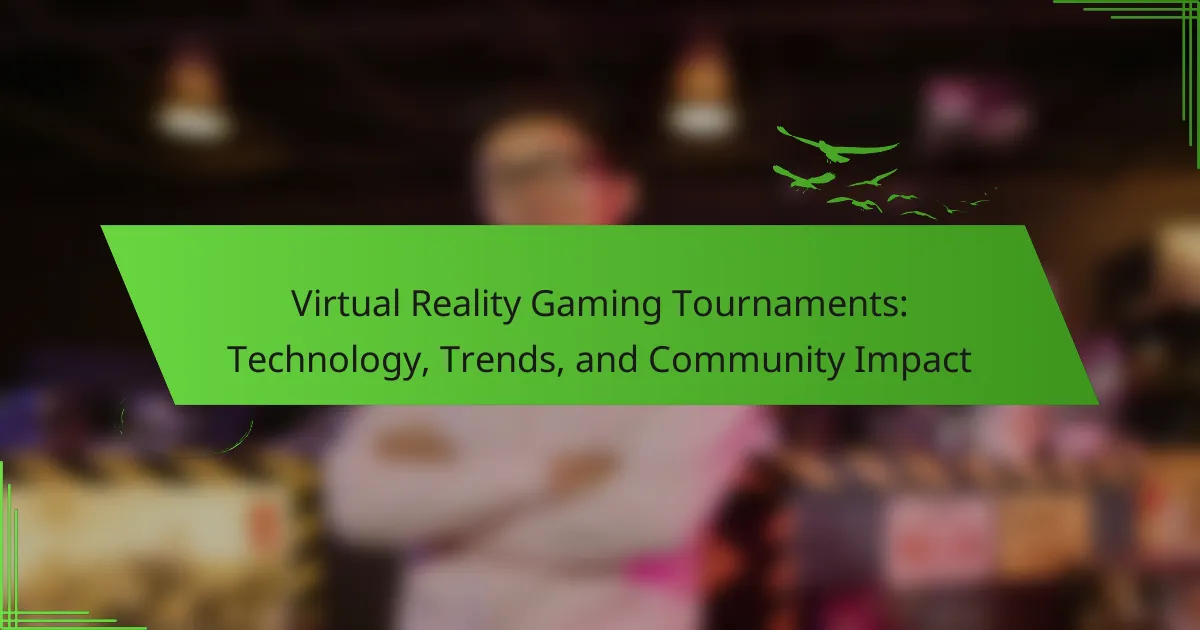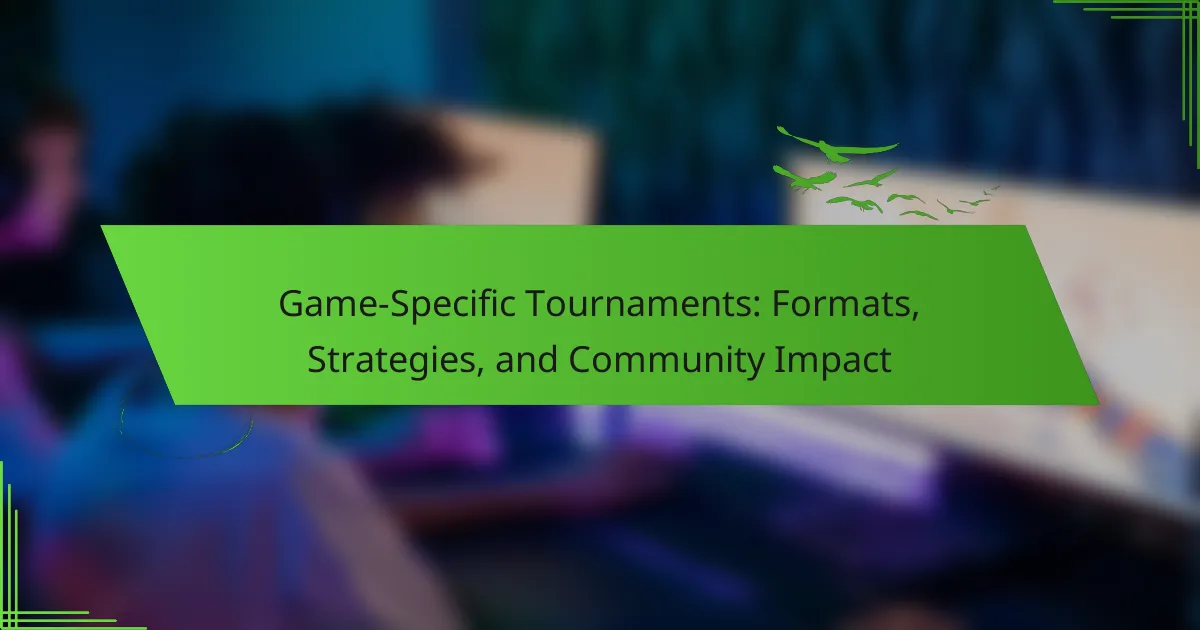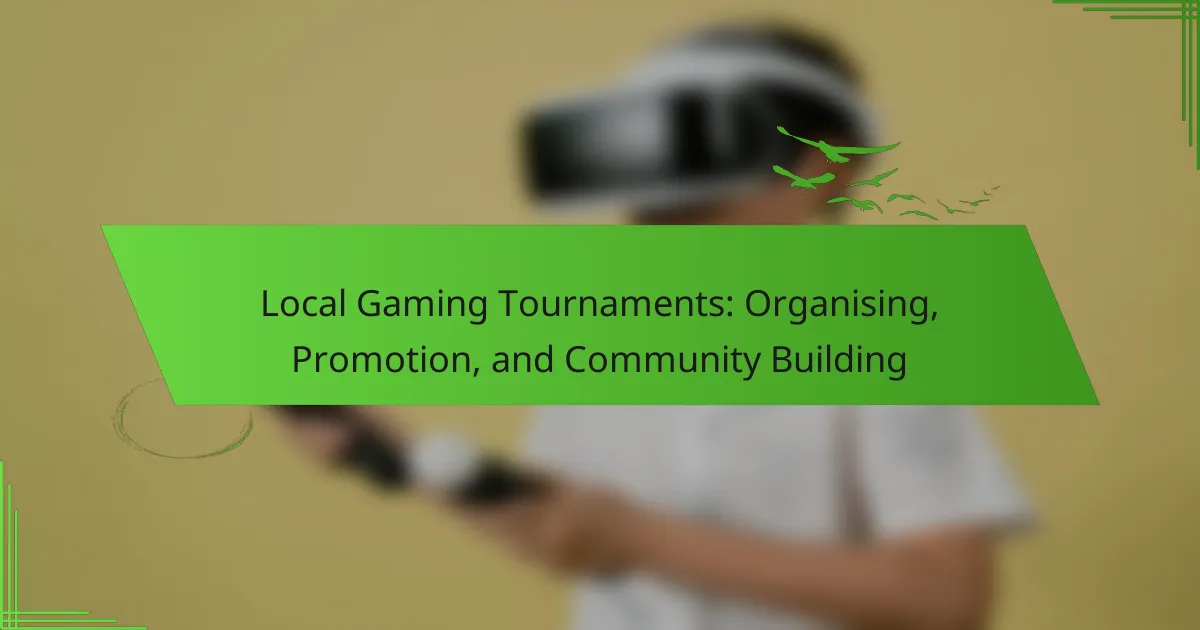Virtual reality gaming tournaments are revolutionising the gaming industry by enhancing player engagement, driving technological advancements, and fostering community connections. These immersive competitions leverage advanced VR technology to create realistic gaming environments. Key trends include increased accessibility, community-driven content, and unique competitive formats. The impact on local economies and social interactions underscores the significance of these tournaments in shaping the future of gaming.
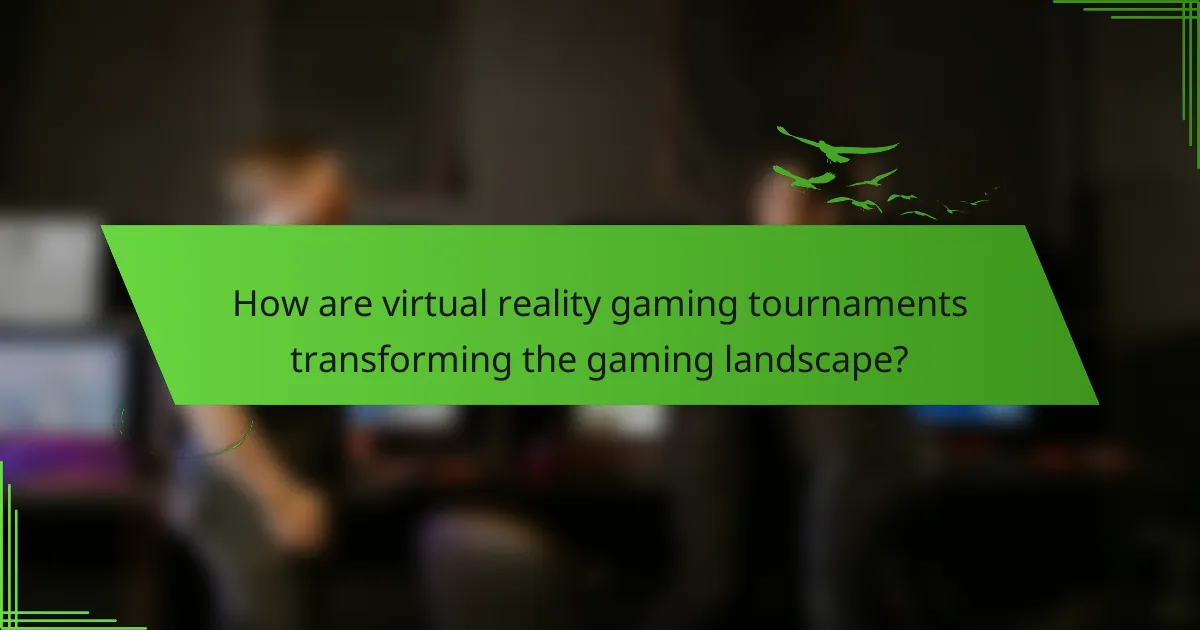
How are virtual reality gaming tournaments transforming the gaming landscape?
Virtual reality gaming tournaments are significantly transforming the gaming landscape by enhancing player engagement, fostering community interaction, and driving technological advancements. These tournaments create immersive experiences that attract diverse audiences and elevate competitive gaming.
The integration of advanced VR technology allows players to engage in realistic environments, increasing the thrill and competitiveness of tournaments. As a result, the demand for VR equipment and software has surged, pushing developers to innovate and improve gaming experiences.
Community impact is profound, as these tournaments promote collaboration and social interaction among players. They provide platforms for networking and skill development, fostering a sense of belonging within the gaming community.
In summary, virtual reality gaming tournaments are reshaping the gaming industry by enhancing engagement, driving technology, and building community connections.
What technological advancements are driving the growth of VR gaming tournaments?
Technological advancements driving VR gaming tournaments include improved hardware, enhanced software, and increased internet speeds. High-performance headsets, like the Meta Quest Pro, deliver immersive experiences. Cross-platform compatibility allows players from different devices to compete, expanding participation. Advanced motion tracking enhances gameplay accuracy, fostering a more engaging environment. Additionally, cloud gaming technology reduces latency, enabling seamless online tournaments. These innovations collectively enhance user experience and community engagement in VR gaming.
Which platforms are most popular for hosting VR gaming tournaments?
The most popular platforms for hosting VR gaming tournaments include Oculus, SteamVR, PlayStation VR, and Viveport. These platforms provide robust infrastructure and community engagement for competitive gaming. Oculus leads in user base, while SteamVR offers extensive game options. PlayStation VR is notable for its console integration, and Viveport focuses on diverse content offerings. These platforms enhance the VR tournament experience with features like matchmaking and live streaming capabilities.
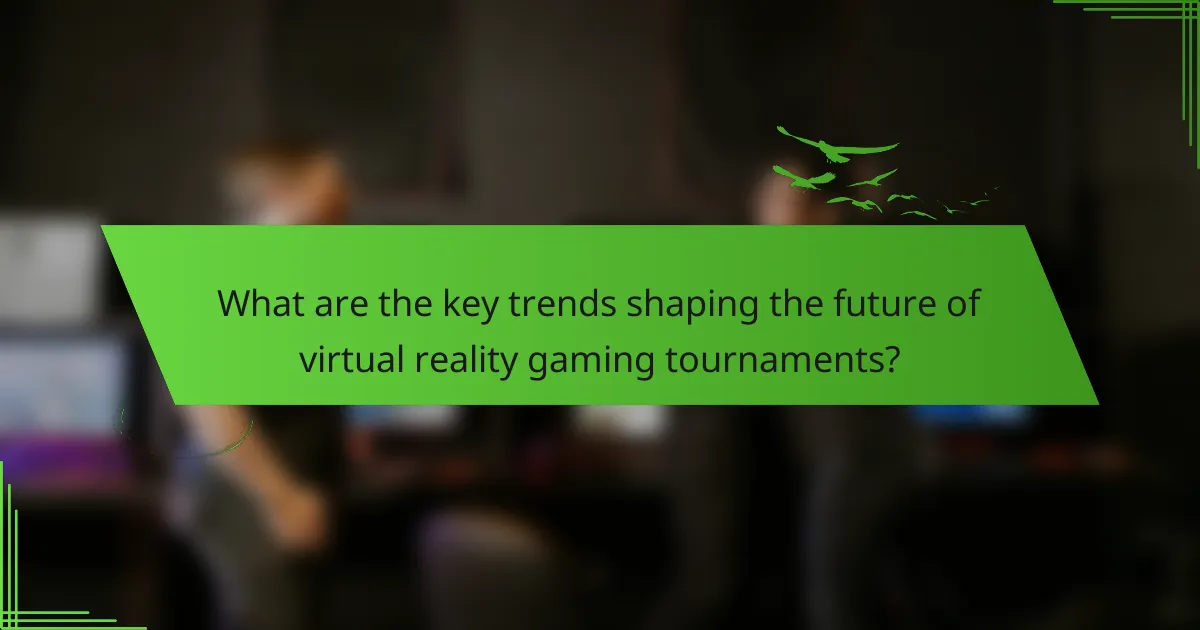
What are the key trends shaping the future of virtual reality gaming tournaments?
Key trends shaping virtual reality gaming tournaments include advancements in immersive technology, increased accessibility, and community-driven content. Enhanced graphics and haptic feedback improve user experiences, while affordable VR headsets attract more participants. Community engagement fosters collaboration and innovation, leading to unique gaming formats and events. As a result, these trends create a more inclusive and dynamic environment for players and spectators alike.
How is player engagement evolving in the context of VR tournaments?
Player engagement in VR tournaments is evolving through immersive experiences and community interaction. Enhanced graphics and real-time feedback foster deeper connections among players. Social features, like voice chat and team dynamics, promote collaboration and competition. Additionally, platforms are integrating AI to personalise experiences, tailoring challenges to individual skill levels. These advancements are transforming how players participate, making tournaments more engaging and accessible.
What role do sponsorships and partnerships play in VR gaming tournaments?
Sponsorships and partnerships significantly enhance VR gaming tournaments by providing financial support and resources. They attract larger audiences and foster community engagement. Major brands often collaborate, offering prizes and marketing opportunities, which boosts tournament visibility. This synergy elevates the overall experience for players and fans alike.
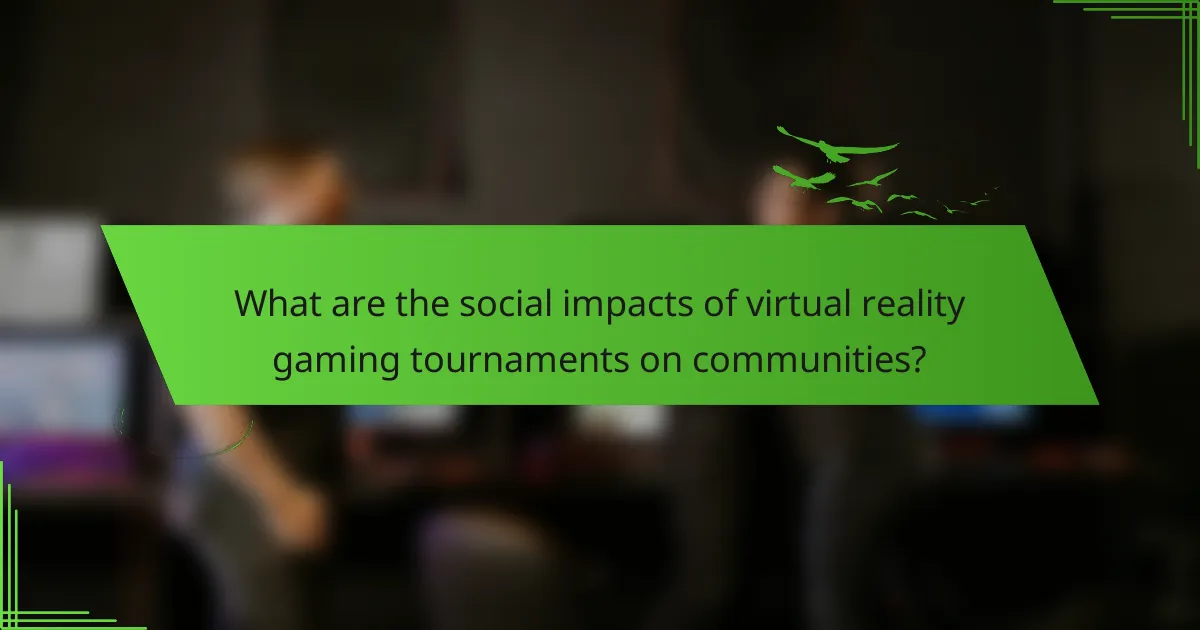
What are the social impacts of virtual reality gaming tournaments on communities?
Virtual reality gaming tournaments positively impact communities by fostering social connections and enhancing local economies. These events create opportunities for networking among participants, promoting teamwork, and building friendships. They also attract tourism, boosting local businesses and generating revenue through hospitality and retail sectors. Moreover, they encourage skill development in technology and teamwork, contributing to community growth. As a result, virtual reality gaming tournaments serve as a catalyst for community engagement and economic development.
How do VR tournaments foster community building among players?
Virtual reality tournaments foster community building among players by creating immersive environments that encourage collaboration and interaction. These events allow participants to connect through shared experiences, enhancing social bonds. Players engage in teamwork, competition, and communication, which strengthens community ties. As a result, virtual reality gaming cultivates a sense of belonging and camaraderie among diverse participants.
What initiatives exist to promote inclusivity in VR gaming tournaments?
Several initiatives promote inclusivity in VR gaming tournaments. Organisations focus on accessibility features, diverse representation, and community engagement.
Programs like “VR for All” offer resources for underrepresented groups, ensuring they can participate fully. Tournaments increasingly adopt adaptive technologies, catering to players with disabilities.
Community-driven events highlight diverse voices, encouraging a broader range of participants. Partnerships with advocacy groups further enhance inclusivity efforts, fostering a welcoming environment.
These initiatives enhance the gaming experience, making VR tournaments more accessible and representative of diverse communities.
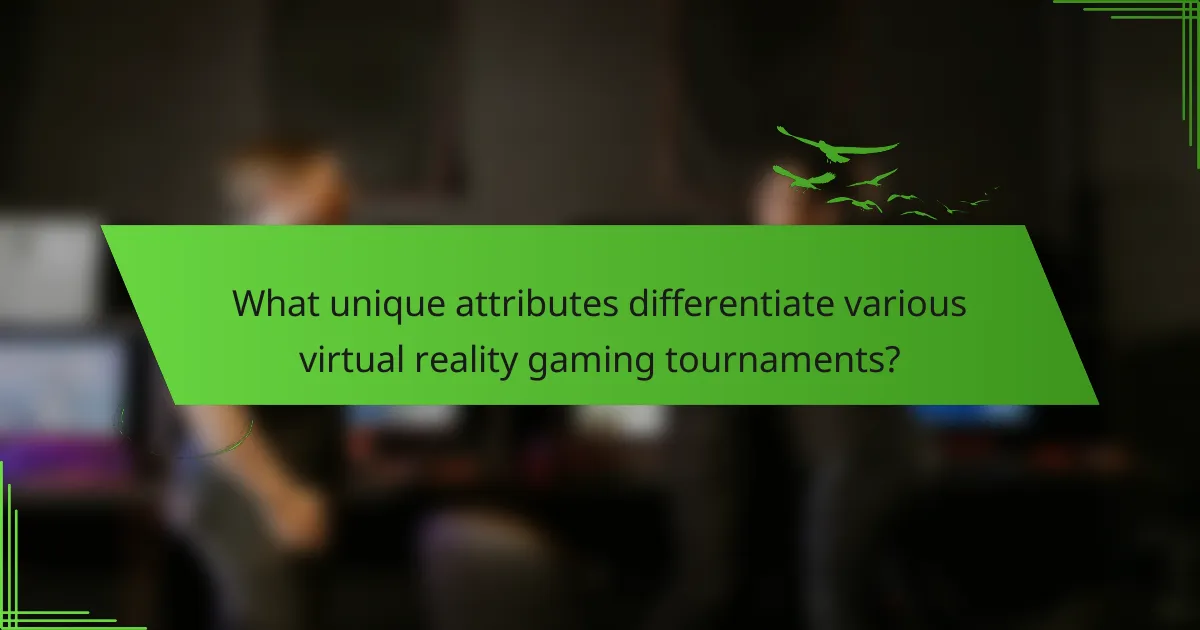
What unique attributes differentiate various virtual reality gaming tournaments?
Unique attributes that differentiate virtual reality gaming tournaments include their technology integration, community engagement, and competitive formats. These tournaments often leverage advanced VR hardware, such as headsets and motion controllers, to create immersive experiences. Community involvement varies, with some tournaments emphasising player collaboration while others focus on individual skill. Additionally, competitive formats can range from casual play to structured leagues, influencing player participation and engagement.
How do tournament formats vary between casual and competitive VR gaming?
Tournament formats in casual and competitive VR gaming differ significantly. Casual tournaments often prioritise fun and accessibility, featuring relaxed rules and a focus on social interaction. In contrast, competitive tournaments emphasise skill, structured formats, and strict regulations to ensure fairness and high-level play.
Casual formats may include single-elimination or round-robin structures, allowing for a more laid-back experience. Competitive formats frequently adopt double-elimination or league play, requiring teams to demonstrate consistent performance across multiple matches.
The community impact also varies; casual tournaments foster inclusivity and engagement, while competitive events often build a more serious player base and can lead to professional opportunities. This distinction shapes how players interact with VR gaming as a whole.
What are the standout features of major VR gaming tournaments?
Major VR gaming tournaments feature immersive technology, competitive gameplay, and community engagement. They utilise advanced VR headsets and motion tracking for realistic experiences. Tournaments often showcase popular games, attract global audiences, and foster player interaction. Unique prize pools and sponsorships enhance their appeal, while community-driven events promote inclusivity and collaboration.
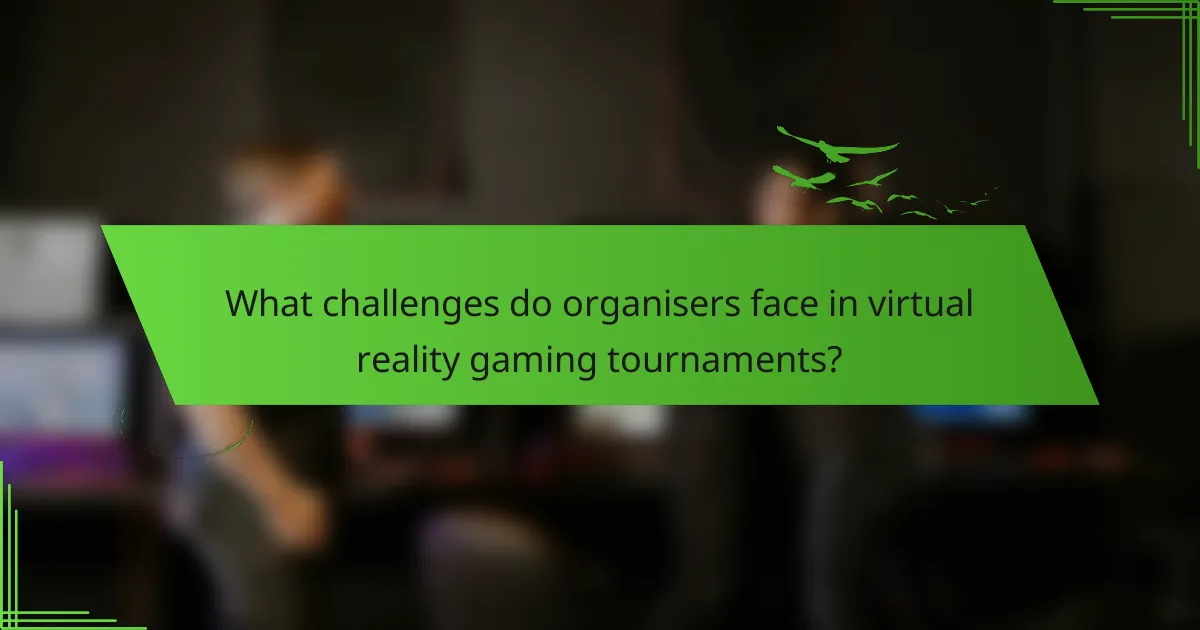
What challenges do organisers face in virtual reality gaming tournaments?
Organisers face various challenges in virtual reality gaming tournaments, including technical issues, participant engagement, and platform limitations. Technical difficulties can arise from hardware malfunctions or software incompatibilities, disrupting gameplay. Ensuring participant engagement is crucial, as VR experiences can sometimes lead to isolation. Additionally, platform limitations may restrict the number of players or the types of games that can be showcased, affecting the overall tournament experience. Addressing these challenges requires innovative solutions and a deep understanding of VR technology and community dynamics.
How do technical issues affect the player experience during VR tournaments?
Technical issues significantly disrupt player experience during VR tournaments. Common problems include latency, hardware malfunctions, and software bugs, leading to frustration and disengagement. High latency can cause delays in player actions, affecting gameplay fluidity. Hardware malfunctions, such as headset failures, can prevent participation altogether. Software bugs may result in crashes or glitches, undermining the competitive integrity. These technical challenges can diminish the overall enjoyment, impacting community engagement and future participation in VR tournaments.
What are common logistical hurdles in organizing VR gaming events?
Common logistical hurdles in organizing VR gaming events include technical challenges, equipment availability, space limitations, and participant coordination. Ensuring sufficient bandwidth is crucial for seamless gameplay. Equipment like VR headsets must be accessible and in working condition. Venue size must accommodate all participants and their setups. Lastly, managing schedules and communication among players is essential for a successful tournament.
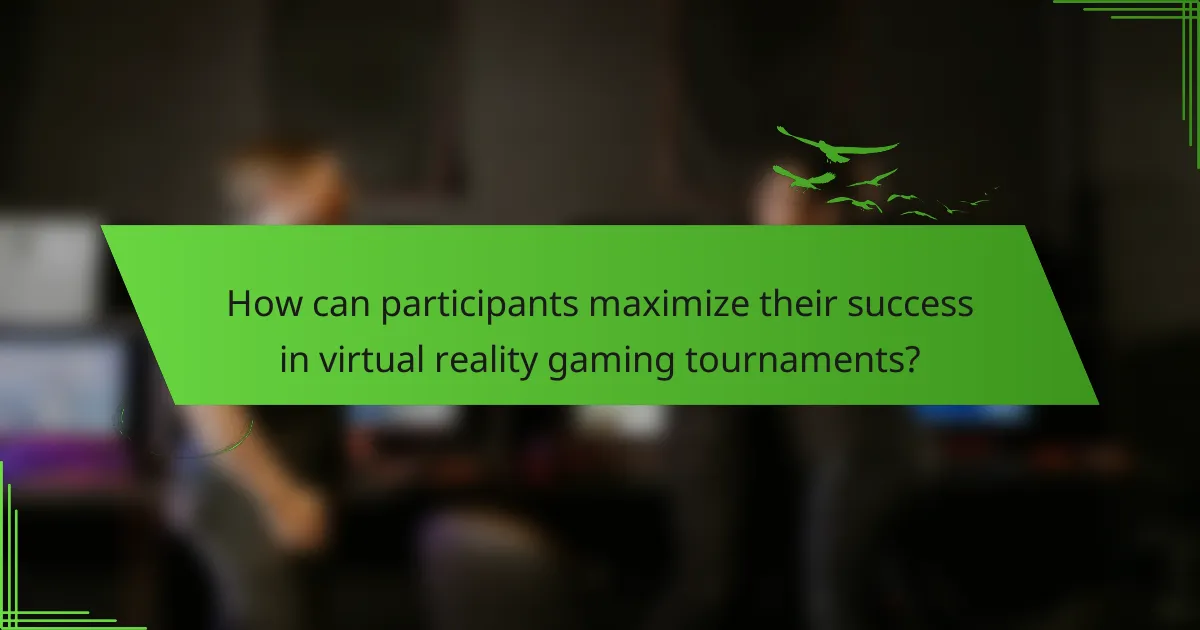
How can participants maximize their success in virtual reality gaming tournaments?
Participants can maximize their success in virtual reality gaming tournaments by practicing regularly, understanding game mechanics, and engaging with the community. Consistent practice enhances skills and reflexes, critical for competitive play. Familiarity with game mechanics allows players to exploit strategies effectively. Additionally, joining forums or social media groups fosters connections and provides insights from experienced players.
Another key factor is optimizing equipment. High-quality headsets and controllers can significantly improve performance. Players should also ensure a stable internet connection to minimize latency. Furthermore, analysing past tournament performances helps identify areas for improvement, enabling targeted practice.
Mental preparation is essential. Players should develop focus and resilience to handle the pressures of competition. Techniques such as visualization and mindfulness can enhance concentration and reduce anxiety. Finally, maintaining a balanced lifestyle, including proper nutrition and rest, supports overall performance in tournaments.
What strategies should players adopt to improve their performance in VR tournaments?
Players should adopt strategies focused on practice, teamwork, and adaptability to improve performance in VR tournaments. Consistent practice enhances skill levels, while effective communication and collaboration with teammates can lead to better in-game strategies. Additionally, being adaptable to different game mechanics and environments is crucial for success. Analysing past performances and learning from mistakes also contributes to continuous improvement.
What are the best practices for preparing for a VR gaming tournament?
To prepare for a VR gaming tournament, focus on practice, equipment, and strategy. Regularly train in your chosen games to improve skills. Ensure your VR setup is optimal, including a high-quality headset and responsive controllers. Analyse competitors’ gameplay to identify strengths and weaknesses. Lastly, engage with the community for tips and support.
What common mistakes should players avoid in VR tournaments?
Players should avoid common mistakes like neglecting practice, underestimating game mechanics, and ignoring communication. Failing to prepare can lead to poor performance. Overconfidence may result in unexpected losses, while poor teamwork can diminish chances of success. Understanding these pitfalls enhances competitive play.
